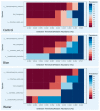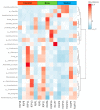The Impact of a Commercial Biostimulant on the Grape Mycobiota of Vitis vinifera cv. Barbera
- PMID: 37630432
- PMCID: PMC10457965
- DOI: 10.3390/microorganisms11081873
The Impact of a Commercial Biostimulant on the Grape Mycobiota of Vitis vinifera cv. Barbera
Abstract
Reducing the use of fungicides, insecticides, and herbicides in order to limit environmental pollution and health risks for agricultural operators and consumers is one of the goals of European regulations. In fact, the European Commission developed a package of measures (the European Green Deal) to promote the sustainable use of natural resources and strengthen the resilience of European agri-food systems. As a consequence, new plant protection products, such as biostimulants, have been proposed as alternatives to agrochemicals. Their application in agroecosystems could potentially open new scenarios regarding the microbiota. In particular, the vineyard microbiota and the microbiota on the grape surface can be affected by biostimulants and lead to different wine features. The aim of this work was to assess the occurrence of a possible variation in the mycobiota due to the biostimulant application. Therefore, our attention has been focused on the yeast community of grape bunches from vines subjected to the phytostimulant BION®50WG treatment. This work was carried out in the CREA-VE experimental vineyard of Vitis vinifera cv. Barbera in Asti (Piedmont, Italy). The composition of fungal communities on grapes from three experimental conditions such as IPM (integrated pest management), IPM+BION®50WG, and IPM+water foliar nebulization was compared by a metabarcoding approach. Our results revealed the magnitude of alpha and beta diversity, and the microbial biodiversity index and specific fungal signatures were highlighted by comparing the abundance of yeast and filamentous fungi in IPM and BION®50WG treatments. No significant differences in the mycobiota of grapevines subjected to the three treatments were detected.
Keywords: Acibenzolar-S-Methyl; ITS region; biodiversity; grape; mycobiota; next-generation sequencing; yeast.
Conflict of interest statement
The authors declare no conflict of interest.
Figures






Similar articles
-
Year, Location, and Variety Impact on Grape-Associated Mycobiota of Arkansas-Grown Wine Grapes for Wine Production.Microb Ecol. 2021 Nov;82(4):845-858. doi: 10.1007/s00248-021-01705-y. Epub 2021 Mar 5. Microb Ecol. 2021. PMID: 33665722
-
Biostimulants as an Alternative to Improve the Wine Quality from Vitis vinifera (cv. Tempranillo) in La Rioja.Plants (Basel). 2022 Jun 16;11(12):1594. doi: 10.3390/plants11121594. Plants (Basel). 2022. PMID: 35736745 Free PMC article.
-
Year, Location, and Variety Impact on Grape-, Soil-, and Leaf-Associated Fungal Microbiota of Arkansas-Grown Table Grapes.Microb Ecol. 2021 Jul;82(1):73-86. doi: 10.1007/s00248-021-01698-8. Epub 2021 Jan 29. Microb Ecol. 2021. PMID: 33515050
-
A review of the use of biostimulants in the vineyard for improved grape and wine quality: effects on prevention of grapevine diseases.J Sci Food Agric. 2019 Feb;99(3):1001-1009. doi: 10.1002/jsfa.9353. Epub 2018 Oct 26. J Sci Food Agric. 2019. PMID: 30198154 Review.
-
Soil management affects carbon and nitrogen concentrations and stable isotope ratios in vine products.Sci Total Environ. 2023 May 15;873:162410. doi: 10.1016/j.scitotenv.2023.162410. Epub 2023 Feb 24. Sci Total Environ. 2023. PMID: 36842594 Review.
Cited by
-
Impact of the Biocontrol Product, Esquive® WP, on the Indigenous Grapevine Wood Microbiome after a 6-Year Application Period.J Fungi (Basel). 2024 Aug 11;10(8):566. doi: 10.3390/jof10080566. J Fungi (Basel). 2024. PMID: 39194892 Free PMC article.
References
-
- Patel V. The gut microbiome. In: Short E., editor. A Prescription for Healthy Living. 1st ed. Academic Press; Cambridge, MA, USA: 2021. - DOI
-
- International Organisation of Vine and Wine Intergovernmental Organisation OIV 2019 Statistical Report on World Vitivinicul-ture. [(accessed on accessed on 12 May 2022)]. Available online: https://www.oiv.int/public/medias/6782/oiv-2019-statistical-report-on-wo....
-
- International Organisation of Vine and Wine Intergovernmental Organisation OIV 2020 Wine production OIV First Estimate 27.10.2020. [(accessed on 12 May 2021)]. Available online: https://www.oiv.int/public/medias/7541/en-oiv-2020-world-wineproduction-....
LinkOut - more resources
Full Text Sources
Research Materials

